The Made In Paring Knife is made by 5th generation french knife makers.
By Timothy Hales | Updated: November 26, 2021
Made In Paring Knife Review Summary
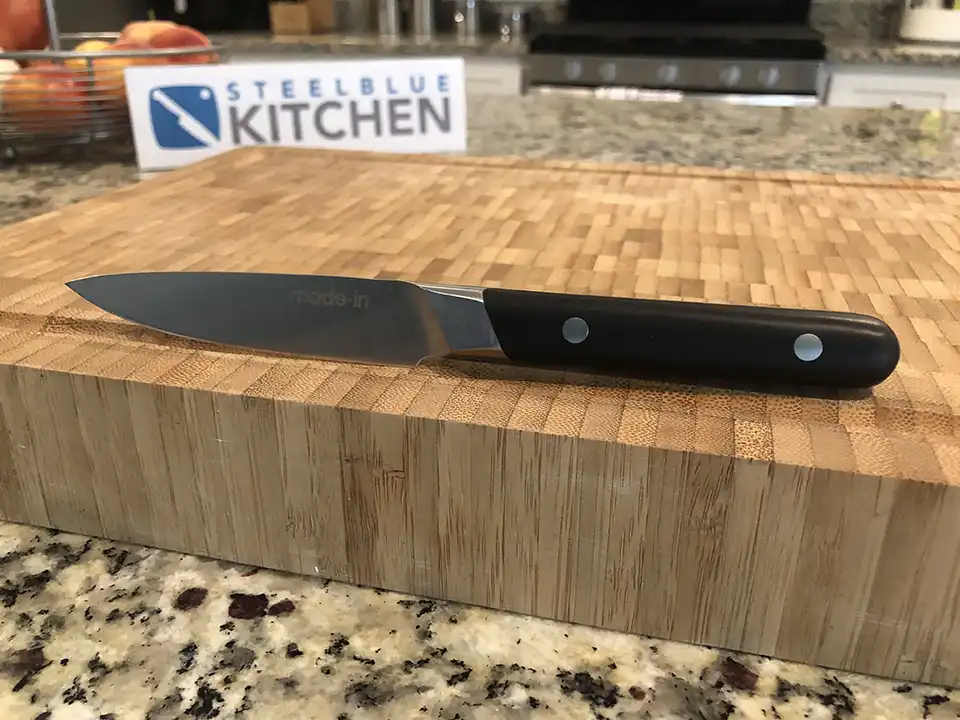
The Made In Paring Knife is crafted in France by 5th generation knife makers. It is made with one of the best types of steel and a high-quality handle. You can tell the quality when you hold it. Its design provides comfort when you hold it in your hand, and with a 22.5 degree angle blade edge, you are sure to have no problems making precision cuts. With three different colors to pick from, you can find the perfect knife for yourself.
Pros
Perfectly balanced to rest in your hand.
Uses the x50crMoV15 metal for the blade.
Sharp edge with an angle of 22.5 degrees.
Lower price because you can buy directly from the manufacturer.
Cons
There is no bolster or edge guard to prevent your finger from slipping onto the back corner of the blade.
Made In Cookware is only a few years old, so it doesn't have the decades of history that other well-known brands have.
Table of Content
What’s included in the box?
Materials and Construction
Design
Kitchen Usability
Cleaning and Maintenance
Company
Value
Should you buy the Made In Paring Knife?
What’s included in the Made In Paring Knife box?
Opening the box for the first time, I was really impressed with the packaging. It was very reminiscent of opening an Apple product. In and of itself, it was an experience that made me, the customer, feel important.
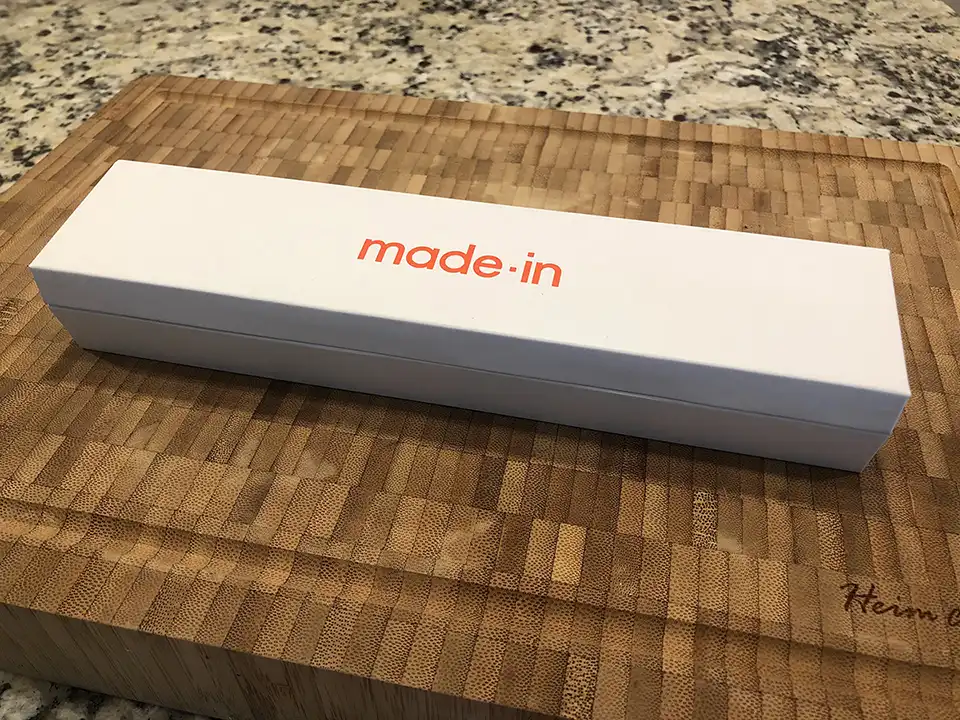
Inside the box was a card that provided information on how to care for your paring knife and tips on how to get the most out of your new paring knife.
They also included a Misen bandaid which gave me a bit of a laugh. Clearly, they believe that their knives are “that” sharp. That is a marketing genius!
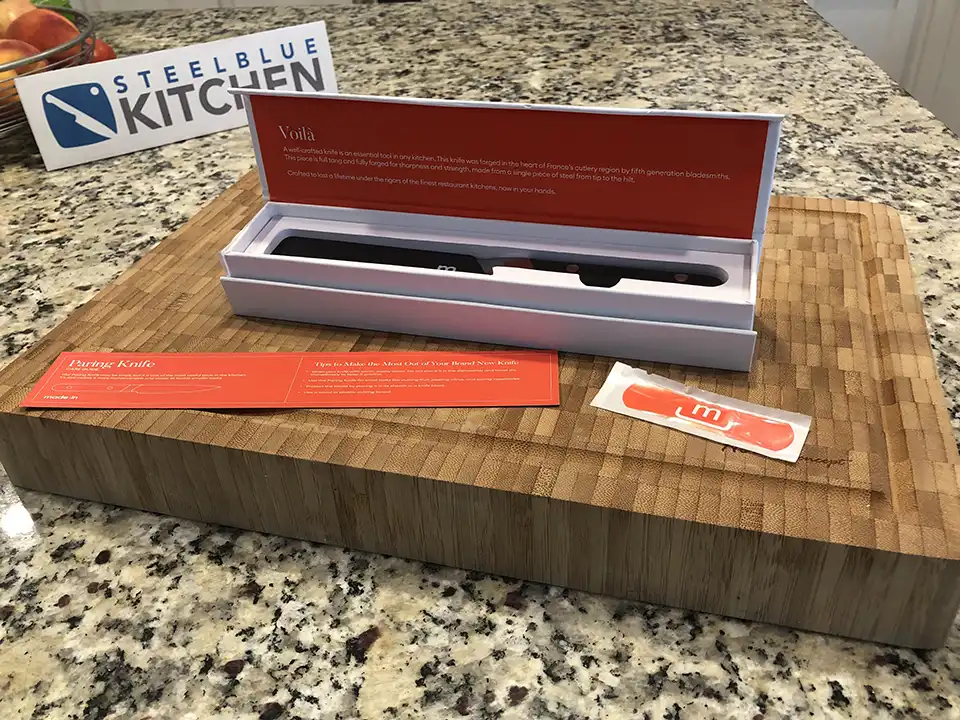
Then of course there was the paring knife with a very nice blade guard.
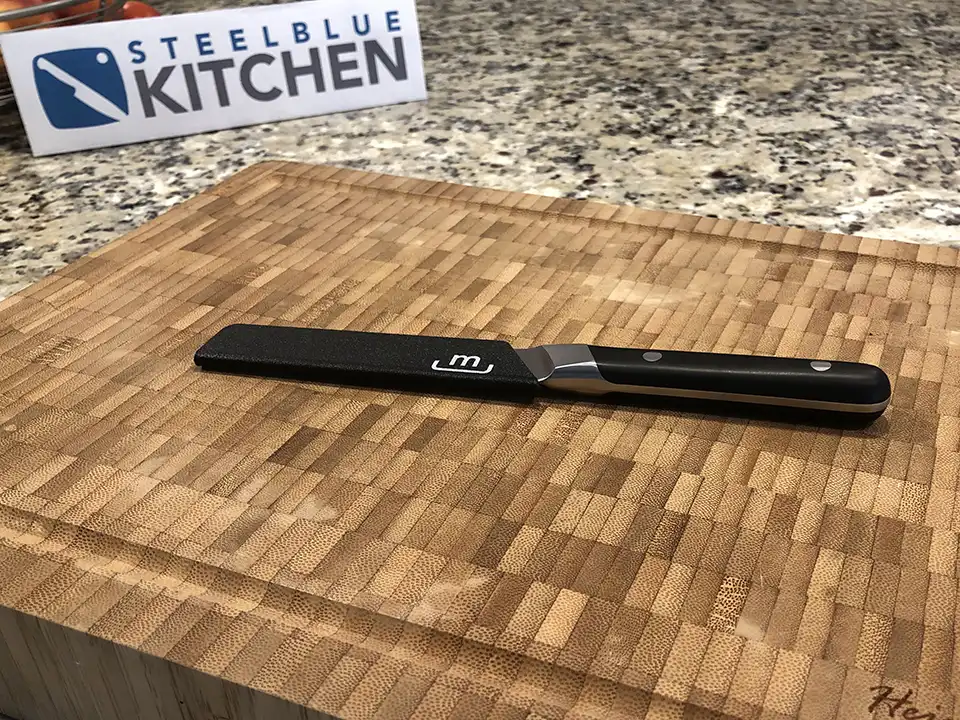
Materials and Construction
Blade Material
The Made In Paring Knife blade is made from a single piece of nitrogen treated X50CrMoV15 stainless steel. This blade has a Rockwell score of 58+ HRC.
A blade with a Rockwell score of 58 is a typical score for quality kitchen knives. It is hard enough to retain blade sharpness but is not so hard that it is susceptible to easily chipping.
Handle Material
After the blade, the knife’s handle is the second most important part of the knife. This knife offers a thick oval shape made up of lightweight plastic and doesn’t put stress on the hand, making it a lot more comfortable to hold.
There are many other shapes of handles available in the market, which includes round shape handles that aren’t that good as they spin in your hand while using them, and even square handles which aren’t that comfortable.
The handle is made of a synthetic resin similar to polyoxymethylene which is basically a high-quality plastic.
This type of material ensures the handle does not fade or discolor, and it also is resistant to damage from moisture and high temps. The non-porous nature of this handle ensures that food, germs, and bacteria can be easily cleaned.
If you purchase the paring knife with the olive wood handle, then, of course, it will have an olive wood handle instead of the plastic.
The olive wood design creates a one-of-a-kind design because of the unique wood grains.
Where is the Made In Paring Knife made?
This paring knife is made by a 5th generation knife maker. All Made In knives are made in their family-owned factory in Thiers, France.
All parts of the knife from the blade, rivets, and handle come from Thiers, France.
They source the X50CrMoV15 metal, and the factory in France forges the blades and adds the resin handles.
And if you’re not familiar with the area around Theirs, that’s where the modern chef knife was invented. Over seventy percents of all French knives come from this region.
How is it made?
The blade is made by taking a single X50CrMoV15 steel rod and treating it with nitrogen. The nitrogen process helps prevent corrosion and adds hardness to the blade.
Each rod is then heated up to glowing red temperature and forged until it reaches its final shape.
Forging is the process of heating a piece of metal up and hammering it into shape. This process ensures a quality blade.
Stamped blades are the alternative and cheaper option to make a blade. It basically cuts out the shape of the blade from a flat piece of metal.
Each knife is buffed, polished, and sharpened until it is ready for its handle.
The handle is added to the blade using rivets. The handle, blade, and rivets are sanded by hand to create a smooth surface.
Design
Blade Design
If we talk about the design, it offers X50CrMoV15 stainless steel (58+ HRC) blade, which is a long-lasting blade as it doesn’t bend easily; thus, it has lower chances of breaking off.
The blade length is 3.8 inches, perfect for a small task that requires perfection and attention to detail. Its total length is just 8 inches which makes it easy to maneuver and use.
There is a half bolster between the handle and the blade.
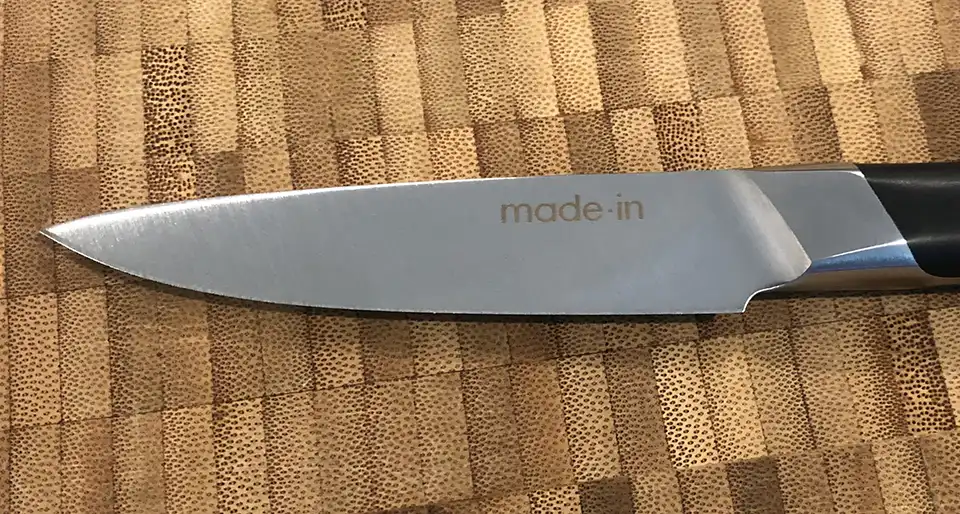
A bolster is where the knife’s thickness is the greatest between the handle and the cutting edge. It is often representative of the original size of the steel rod used to make the knife.
A full bolster extends from the spine of the blade all the way to the cutting edge. A half bolder usually stops right at or just under the handle and does not go all the way to the edge.
A half bolster allows you to sharpen the entire edge of your knife, but it also exposes the back edge of the blade. If you are not careful, you could slide your finger up on the blade.
With the Made In Paring Knife, I found myself allowing my finger to slide up to the blade. Although I didn’t cut myself, I found it slightly uncomfortable. But with the extra length of the handle, there is plenty of room for your finger to avoid the blade.
There are benefits and negatives to this kind of bolster.
The Made In logo is engraved on both sides of the blade. Being on both sides is a thoughtful touch, whether you are right or left-handed.
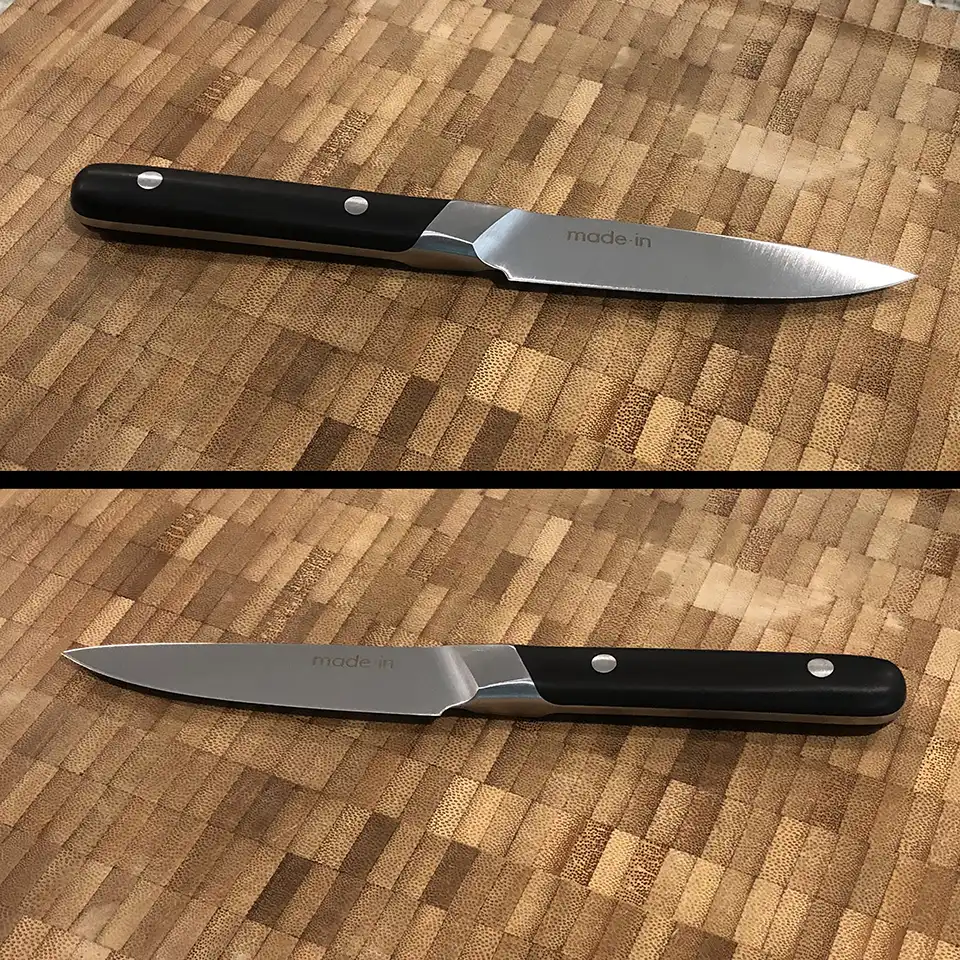
Handle Design
It has a plastic handle which makes it easy to grip because of the thick oval shape, and the plastic handle also makes it light in weight. Being lightweight allows your arm to be fatigue-free, and you can use it for a long time.
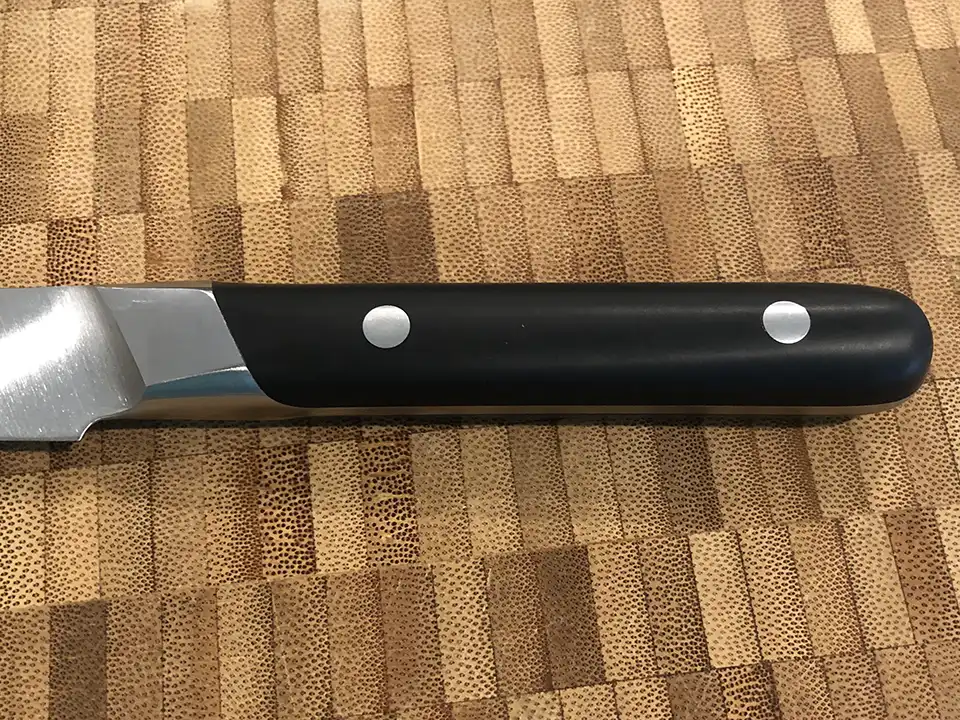
The handle comes in three different colors: Pomme Red, Truffle Black, and Olive wood. I like the pop of the red color, which helps it stand out in a busy kitchen.
Note that the olive wood handle is about $30 more than the red and black handles.
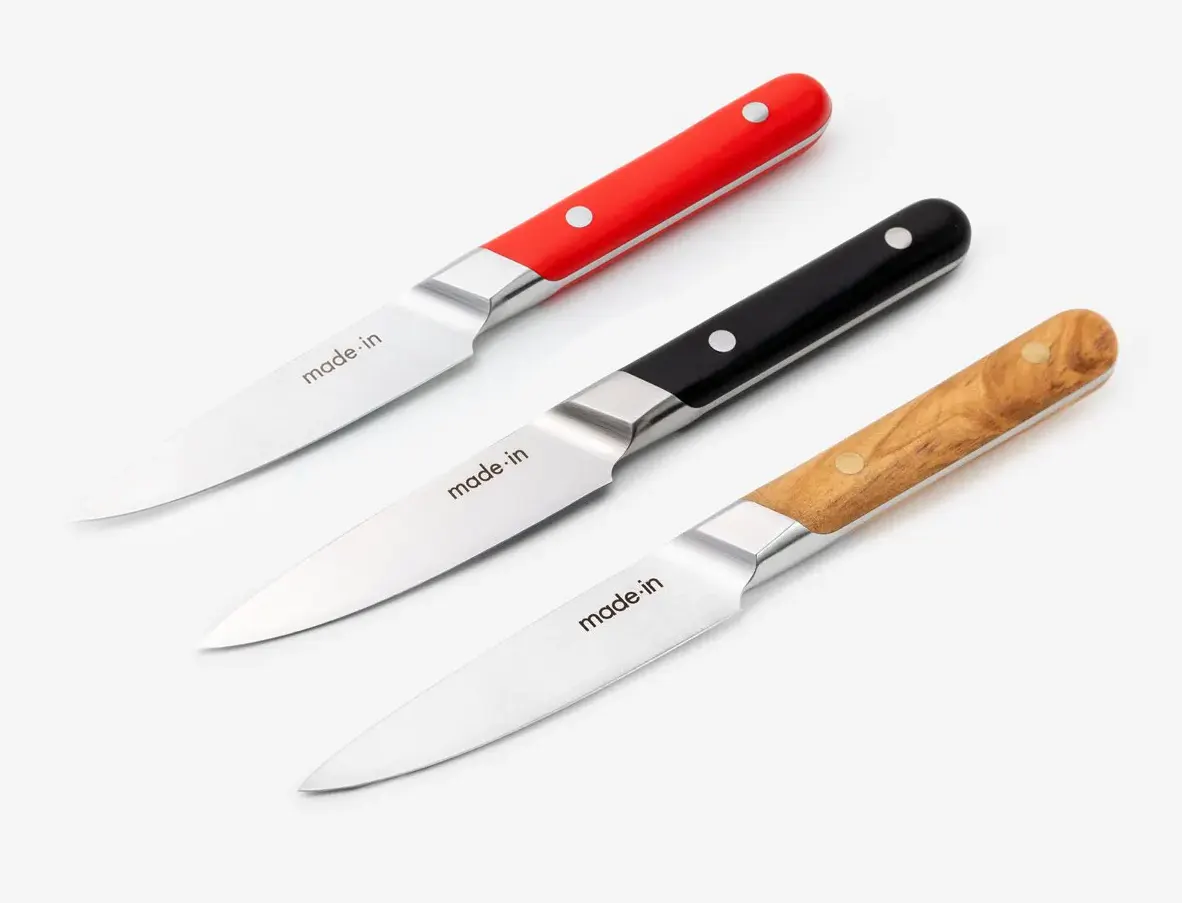
Balance
It is designed in a way that it keeps its balance in anyone’s hand as most people like their knives to be weighted at the handle or maybe at the blade bolster.
Made In’s Paring Knife is well-balanced at 3.4 oz and feels very comfortable holding it in your hand.
This weight is a full ounce more than the Wusthof Classic Paring Knife. The heavier weight is not necessarily a bad thing, but just to show that it is one of the heavier paring knives on the market.
The extra weight is mainly from the extra metal in the blade and tang.
It has a full tang that has the metal blade running all the way through the end of the handle. The full tang balances the cutting edge with the handle.
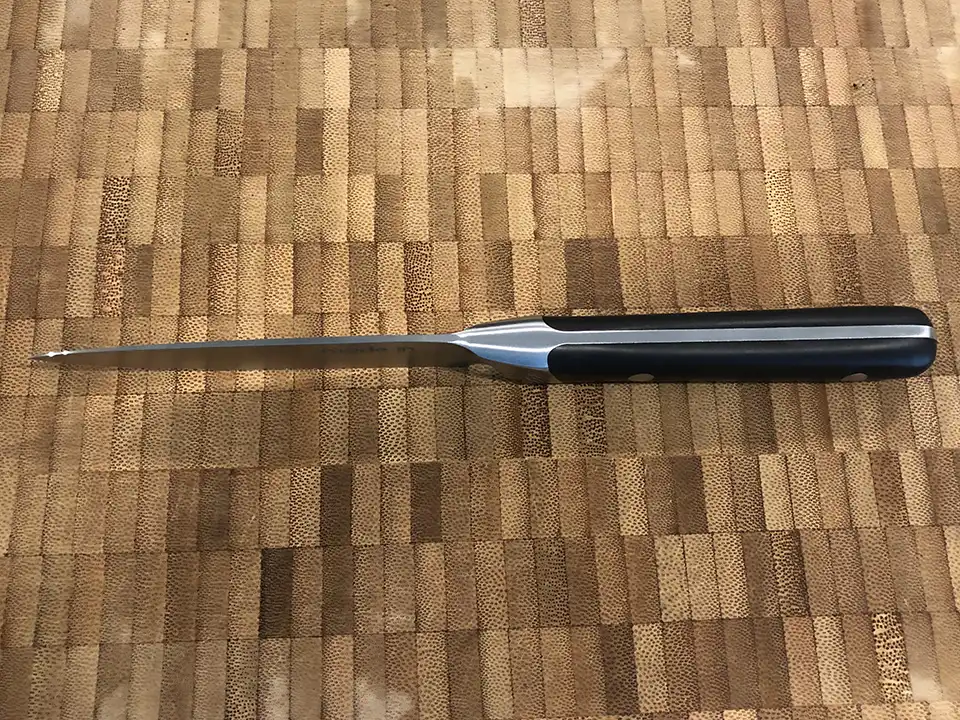
The handle is 4.3” and the blade is 3.9”, making the total length 8.2”.
The total length of the paring knife is a little longer than Wusthof Classic Paring Knife, which is just under 7.5”, and the Mercer Genesis Paring Knife at just under 8”.
Sharpness
The edge of the paring knife is 11.25 degrees on each side, giving it a total edge of 22.5 degrees.
If you are not familiar with the edge angle, just know that the lower the degree angle, the sharper the knife. It is common for chef knives to be sharpened at a 30-degree angle.
So with a total edge angle of 22.5 degrees, that is a pretty thin edge and means it is incredibly sharp.
Design Details
| Weight | 3.4 oz |
| Length | Blade: 3.8″ (advertised) 3.9″ (actual) Handle: 4.3″ (actual) Full length: 8″ (advertised) 8.25″ (actual) |
| Blade | Forged German Stainless Steel x50crMoV15 |
| Handle | Riveted Polyoxymethylene (POM) |
| Tang | Full Tang |
| Edge Angle | 11.25 degrees on each side (22.5 degrees total) |
| Made In | France |
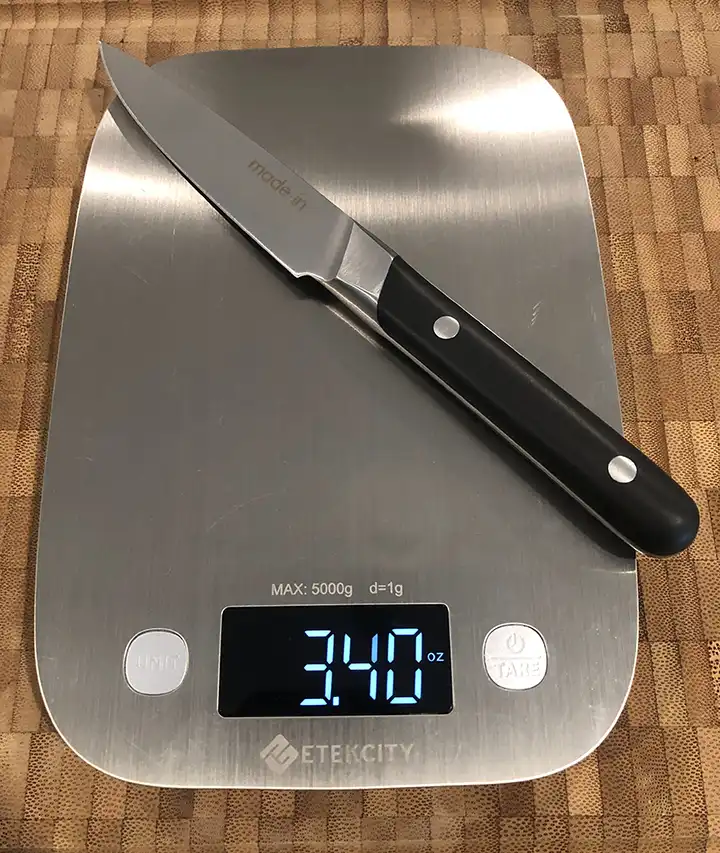
Kitchen Usability
Let’s move on from the technical details of this paring knife and talk about what it’s like to use it in the kitchen.
Because let’s be honest, it is totally different testing a knife in a lab compared to a home kitchen.
The first thing that I noticed was the larger handle. So many paring knives have small handles that can be uncomfortable to hold for those with larger hands.
The straight, smooth handle makes it perfect for any hand size. The handle being straight and rounded at the edges allowed me to place my finger and any position to hold the paring knife.
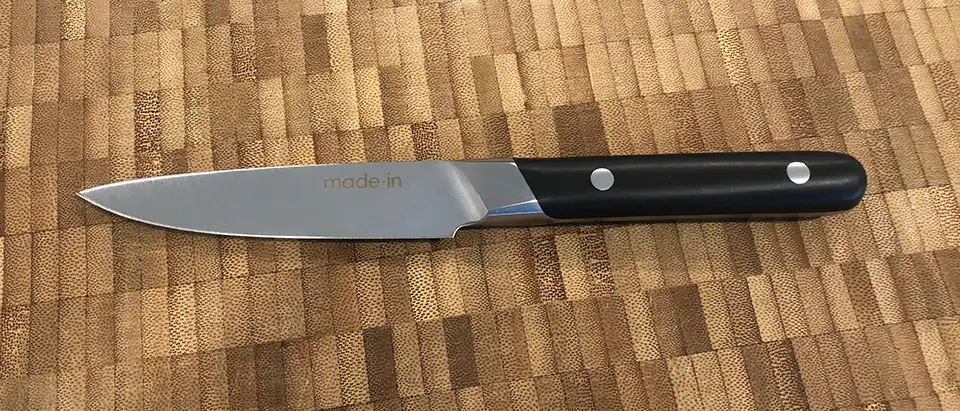
As mentioned earlier, I found that if I let my hand drift too far forward, it bumps up against the back corner of the blade. Not enough to cut you, but enough to tell you that you should probably reposition your hand.
I used this knife for everyday small cuts cutting up a lot of apples, plums, and onions. My wife and kids also grabbed this paring knife to cut cheese and small tomatoes.
Overall it did its intended purpose, cutting small foods. And it did it well. After each use, I washed it and returned it to its sheath. I even found I could put the paring knife with the sheath in most of my knife block slots.
I found myself gravitating to it to cut larger foods like chicken and steak. But the Made In Chef Knife with its 8” blade is a much better choice.
Cut Test Results
Grapes: I don’t typically cut up grapes, but I found this paring knife to slice thin layers of grapes easily.
Apples: I found it very easy to make thinly sliced apples in addition to regular slices. The balance and comfort of the handle allowed me to remove the core easily.
Plum: The blade of this knife glided through the thick skin of the plum without any resistance.
Onions: I didn’t have any issues cutting through the onion skin. But the length was not ideal.
Potatoes: I used this paring knife to peel potatoes. The thin edge quickly removed the skin without taking too much of the main part of the potato.
Cheese: Cheese is always challenging to cut unless you have a super-thin blade. There were no issues cutting cheese slices besides a little bit of resistance from the cheese sticking to the blade.
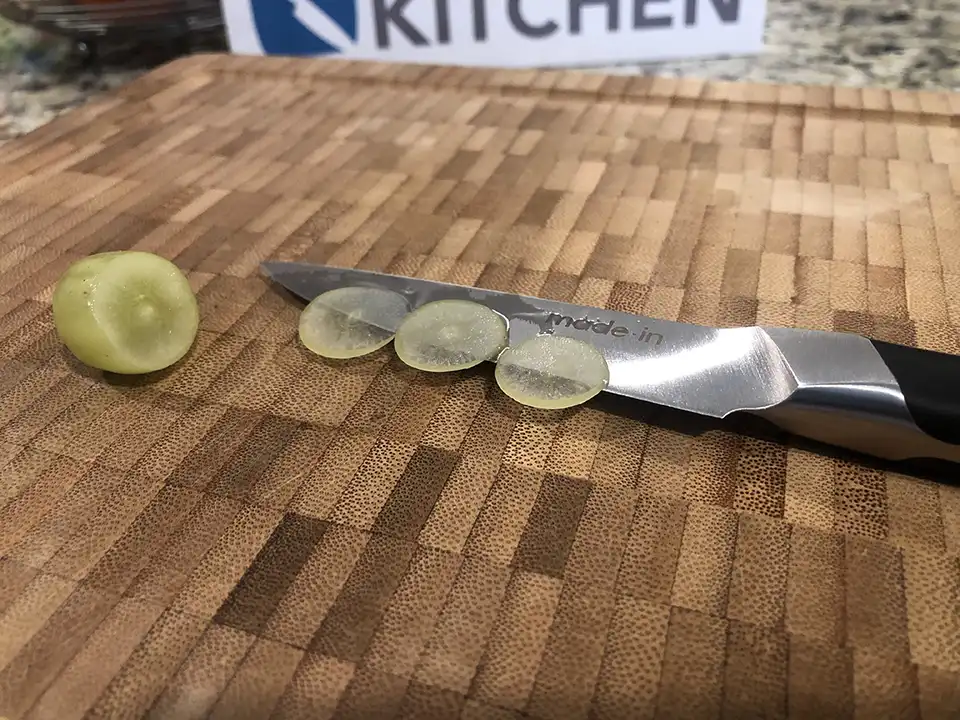
Cleaning and Maintenance
Is the Made In Paring Knife dishwasher safe?
It is essential to take care of your paring knife. These strong blades may seem tough, but they require care. If you are thinking of putting them in the dishwasher, then you are wrong. The dishwasher can damage the blade. The dishwasher has a harsh environment that can cause scratches and rust the blade, or maybe it decolorizes the blade, resulting in a dull knife.
It is always better to wash your paring knife after every time you use it. Just use the simple hot tap water to rinse the blades well with some dishwashing soap. Once they are out of the soapy bath, it’s time to dry them, which is vital as it may cause the blade to rust if not immediately dried.
How to keep your Made In Paring Knife sharp?
Here are some basic tips to keep your Made In knife sharp:
- Use a wood or plastic cutting board to protect the edge
- Wash your knife after each use with soap and warm water
- Dry your paring knife immediately after washing
- Never put your knife in a dishwasher
- Keep your knife blade covered with the included sheath or in a knife block
How to sharpen the Made In Paring Knife?
Your paring knife edge will dull over time with use. You can hone and sharpen your knife to keep it sharp.
Honing your knife is the process of realigning the edge of your knife blade, and it usually removes very little metal from your blade, if any. You can regularly hone your knife without any issues.
You can sharpen your knife with a whetstone. This process will remove more material from your knife than honing, but it is necessary when you cannot get your edge to return from honing. You should not sharpen your paring knife like this more than one or two times a year. If you are looking for more information on sharpening your Made In Paring Knife, check out the Made In care guide.
Company
Made In Cookware is a company formed by Chip and Jake. They are from families who were in the kitchen supply business for over a hundred years. This history motivated these two young men to try something new by combining all the knowledge they got from their families and merging them with today’s technology.
They used the finest raw material suppliers and manufacturers from the US and Western Europe. Made In Cookware brought many professionals on board and created the finest of the finest culinary tools that are today being used in the most top-rated hotels and many independent restaurants.
They have also received over 20,000 five-star reviews for their amazing tools from many home chefs, and they are still working on making your kitchen experience wonderful. Their products are designed for high performance and durability and have a wide range of products from which you can choose.
Where can you buy Made In Paring Knife?
The Made In Paring knife is only available at MadeInCookware.com. They do not have a brick-and-mortar store, and there are no other online retailers.
Having only their online store is a good thing as there is no middle man to up the price. You are getting the best price possible by buying directly from Made In.
Return Policy
Their return policy is straightforward, and they make sure that there are no returns as they make the best culinary tools.
You can still return any cookware, knives, and bakeware, and tabletop items within 45 days of the delivery date. You can get a full refund, you can exchange the product, or you can simply get store credit. If you are from the US, Made In has got you covered in return shipping.
Consumable items, final sale items, limited editions, or customized items are not eligible for the return policy.
Warranty
The products produced by Made In are designed to withstand anything a home or commercial kitchen has to offer. These products are covered for any manufacturing defect with a limited lifetime warranty.
Other than the limited lifetime warranty, you can return or exchange your knife within 45 days of receiving it for an exchange, store credit, or a full refund. They will even cover the return shipping costs if you are in the United States.
Value
The Made In Paring knife price at the time of this article comes in under $50. And I have even seen it on sale for 15-20% off on occasion. I believe this is an excellent price for this high-quality paring knife.
Compared to other paring knives like the Wusthof paring knife, it is almost half the price. Sure, you can get paring knives for $20-30, but the quality does not compare.
I believe the value you receive from this knife exceeds what you pay for it. Plus, you get a company that is dedicated to making sure you are happy with your purchase.
Should you buy the Made In Paring Knife ?
There are more pros than cons for the Made In Paring Knife. And I feel that just looking over this list will give you enough reason to consider buying this knife.
Pros
- Perfect balance when resting in your hand because of the longer length and full tang design.
- Uses the x50crMoV15 metal for the blade, which is the same metal like many other quality knives.
- Rockwell Hardness score of 58, which is a perfect blend between edge retention and easiness to sharpen.
- Extremely sharp edge with an angle of 22.5 degrees.
- Comes in three colors: Pomme Red, Truffle Black, and Olive wood
- Lower price because you can buy directly from the manufacturer.
Cons
- Made In has only been around for a couple of years, so it’s not a pretty well-known household name like Wusthof or Victorinox. Although it doesn’t come with centuries of experience, you also don’t have to pay extra for the company name.
- I didn’t like not having a full bolster to keep my finger away from the point of the back corner of the blade. That’s just something I’ve got to train myself to avoid doing.
Revision History
November 26, 2021 – Published.